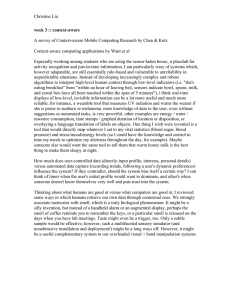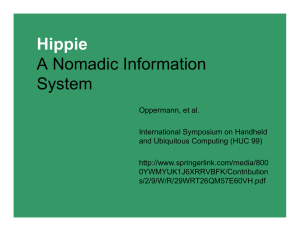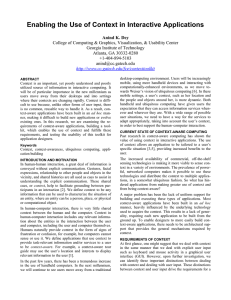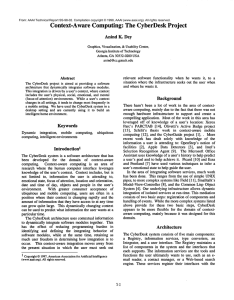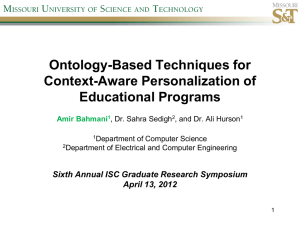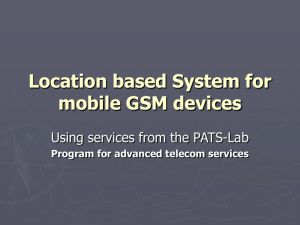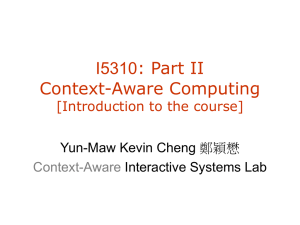The Context Toolkit: Aiding the Development of Context-Aware Applications
advertisement
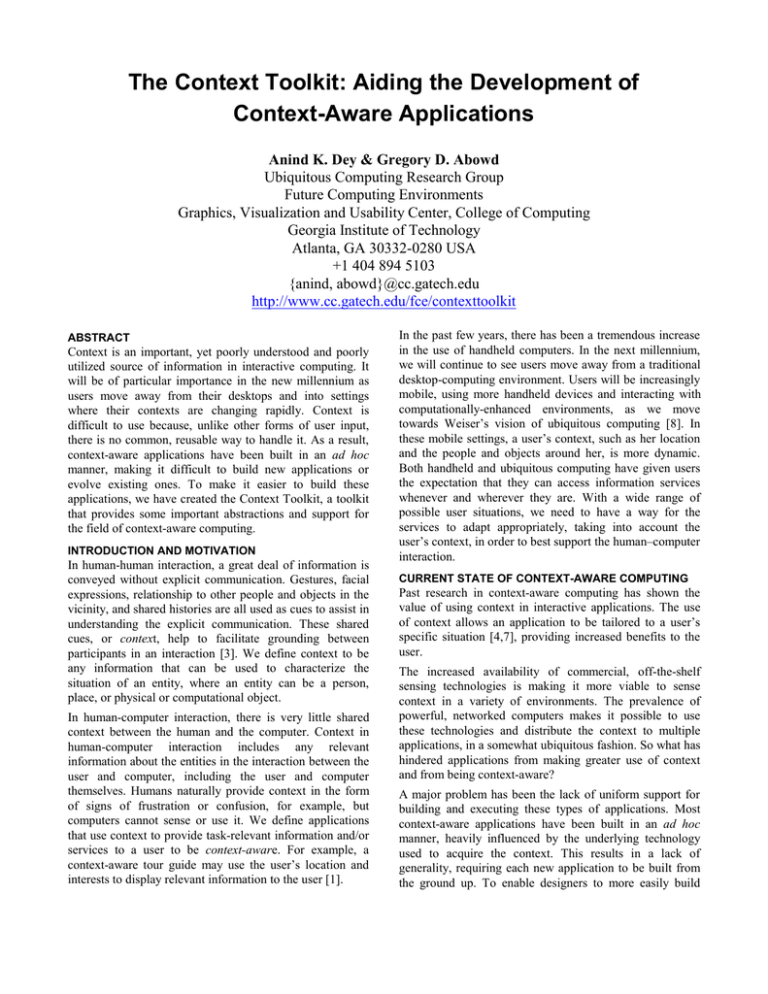
The Context Toolkit: Aiding the Development of
Context-Aware Applications
Anind K. Dey & Gregory D. Abowd
Ubiquitous Computing Research Group
Future Computing Environments
Graphics, Visualization and Usability Center, College of Computing
Georgia Institute of Technology
Atlanta, GA 30332-0280 USA
+1 404 894 5103
{anind, abowd}@cc.gatech.edu
http://www.cc.gatech.edu/fce/contexttoolkit
ABSTRACT
Context is an important, yet poorly understood and poorly
utilized source of information in interactive computing. It
will be of particular importance in the new millennium as
users move away from their desktops and into settings
where their contexts are changing rapidly. Context is
difficult to use because, unlike other forms of user input,
there is no common, reusable way to handle it. As a result,
context-aware applications have been built in an ad hoc
manner, making it difficult to build new applications or
evolve existing ones. To make it easier to build these
applications, we have created the Context Toolkit, a toolkit
that provides some important abstractions and support for
the field of context-aware computing.
INTRODUCTION AND MOTIVATION
In human-human interaction, a great deal of information is
conveyed without explicit communication. Gestures, facial
expressions, relationship to other people and objects in the
vicinity, and shared histories are all used as cues to assist in
understanding the explicit communication. These shared
cues, or context, help to facilitate grounding between
participants in an interaction [3]. We define context to be
any information that can be used to characterize the
situation of an entity, where an entity can be a person,
place, or physical or computational object.
In human-computer interaction, there is very little shared
context between the human and the computer. Context in
human-computer interaction includes any relevant
information about the entities in the interaction between the
user and computer, including the user and computer
themselves. Humans naturally provide context in the form
of signs of frustration or confusion, for example, but
computers cannot sense or use it. We define applications
that use context to provide task-relevant information and/or
services to a user to be context-aware. For example, a
context-aware tour guide may use the user’s location and
interests to display relevant information to the user [1].
In the past few years, there has been a tremendous increase
in the use of handheld computers. In the next millennium,
we will continue to see users move away from a traditional
desktop-computing environment. Users will be increasingly
mobile, using more handheld devices and interacting with
computationally-enhanced environments, as we move
towards Weiser’s vision of ubiquitous computing [8]. In
these mobile settings, a user’s context, such as her location
and the people and objects around her, is more dynamic.
Both handheld and ubiquitous computing have given users
the expectation that they can access information services
whenever and wherever they are. With a wide range of
possible user situations, we need to have a way for the
services to adapt appropriately, taking into account the
user’s context, in order to best support the human–computer
interaction.
CURRENT STATE OF CONTEXT-AWARE COMPUTING
Past research in context-aware computing has shown the
value of using context in interactive applications. The use
of context allows an application to be tailored to a user’s
specific situation [4,7], providing increased benefits to the
user.
The increased availability of commercial, off-the-shelf
sensing technologies is making it more viable to sense
context in a variety of environments. The prevalence of
powerful, networked computers makes it possible to use
these technologies and distribute the context to multiple
applications, in a somewhat ubiquitous fashion. So what has
hindered applications from making greater use of context
and from being context-aware?
A major problem has been the lack of uniform support for
building and executing these types of applications. Most
context-aware applications have been built in an ad hoc
manner, heavily influenced by the underlying technology
used to acquire the context. This results in a lack of
generality, requiring each new application to be built from
the ground up. To enable designers to more easily build
context-aware applications, there needs to be architectural
support that provides the general mechanisms required by
context.
widgets, aggregators hide even more complexity about
the context-sensing mechanisms.
•
REQUIREMENTS OF CONTEXT
At first glance, one might suggest that we deal with context
in the same manner that we deal with explicit user input
such as keyboard and mouse activity in a graphical user
interface (GUI). However, upon further investigation, we
can identify three important distinctions between dealing
with context and dealing with user input. These distinctions
between context and user input drive the requirements for a
toolkit to support the development of context-aware
applications.
The first distinction is that in traditional desktop computing
applications, the source of user input is from a single
computer, but with context-aware applications, the source
of context is from many, distributed computers. Both user
input and context require abstractions to separate the details
of the sensing mechanisms from the use of the sensed
information. A second distinction is that the use of context
requires additional abstractions because context is often not
in the form required by an application. For example, a
keyboard provides the character-level input that an
application requires. But, a global positioning system (GPS)
provides location information in latitude-longitude format,
whereas a context-aware application may require the name
of the street the user is on. A third distinction is that GUI
widgets that acquire user input belong to the application
that instantiated them, whereas components that acquire
context do not belong to an application, but instead execute
independently of an application. This independence is
required because context acquisition components must
often provide context information to multiple context-aware
applications running simultaneously.
CONTEXT TOOLKIT
We have built a toolkit in Java that addresses the
distinctions between context and user input. The toolkit
enables application developers to built context-aware
applications. It consists of three main abstractions:
•
•
Widgets. Just as GUI widgets mediate between a user
and an application, context widgets mediate between a
user and the environment [6]. Context widgets
encapsulate information about a single piece of
context, such as location or activity, for example. They
provide a uniform interface to components or
applications that use the context, hiding the details of
the underlying context-sensing mechanisms. Widgets
support traditional poll and subscription mechanisms.
Aggregators. Context aggregators can be thought of as
meta-widgets, taking on all capabilities of widgets, plus
providing the ability to aggregate context information
of real world entities such as users or places. By acting
as a gateway between applications and elementary
Interpreters. A context interpreter is used to abstract
or interpret low-level context information into higher
level information. For example, identity, location, and
sound level information could be used to interpret that
a meeting is taking place.
The toolkit makes the distributed nature of context
transparent to context-aware applications. Applications do
not need to know whether these context components are
being executed remotely or locally. All of the components
share a common communications mechanism (XML over
HTTP) that supports the transparent distribution. These
components run independently of any single application,
allowing them to be used by multiple applications. Figure 1
shows an example configuration of the Context Toolkit in
support of a context-aware application.
Application
Aggregator
Interpreter
Interpreter
Widget
Widget
Context
Architecture
Sensor
Sensor
Figure 1: Sample configuration of context components.
Arrows indicate data flow.
CURRENT STATUS AND FUTURE RESEARCH
The goal of our research is to provide a toolkit that makes it
easier for application developers to use context. The toolkit
will enable developers to add context to applications that
are not context-aware and to increase the use of context in
applications that are already context-aware. We have
completed the first public version of our context toolkit and
it is being used by members of our research group as well
as by other research institutes.
A number of applications have been built that demonstrate
the usefulness of the Context Toolkit:
•
an In/Out Board that displays which members of our
research group are in the building [6];
•
an information display that shows relevant information
to the user standing in front of it [6];
•
a context-aware mailing list that delivers email only to
those list subscribers who are currently in the building;
•
an augmented electronic whiteboard that begins
recording handwriting and audio when it detects the
presence of users in front of it. The user information is
also used to aid in retrieval of the captured session at a
later time; and,
•
a Conference Assistant, that aids a conference attendee
in determining what presentations are of interest to her,
in capturing the presentation and taking notes, in
maintaining an awareness of their colleagues, and in
retrieving their notes [4].
We are currently attempting to identify a design process
and a set of heuristics for building context-aware
applications. We are working on extensions to the Context
Toolkit that include support for dealing with uncertain or
ambiguous context data and for controlling access to
personal/private context data. We plan to study contextaware application developers to determine whether the
Context Toolkit makes it easier to develop context-aware
applications and whether their context solutions are
reusable by other developers.
The Context Toolkit is available for download at
http://www.cc.gatech.edu/fce/contexttoolkit.
ACKNOWLEDGMENTS
This work was supported by a Motorola University Partner
in Research fellowship.
REFERENCES
1. Abowd, G.D. et al. Cyberguide: A mobile context-aware tour
guide. Baltzer/ACM Wireless Networks, 1997, 3 (5), pp. 421433.
2. Brotherton, J.A., Abowd, G.D. and Truong, K.N. Supporting
capture and access interfaces for in-formal and opportunistic
meetings. Georgia Tech Technical Report, GIT-GVU-99-06,
1998.
3. Clark, H.H. & Brennan, S.E. Grounding in communication. In
L.B. Resnick, J. Levine, & S.D. Teasley (Eds.), Perspectives
on socially shared cognition. Washington, D.C. 1991.
4. Dey, A.K. et al. The Conference Assistant: Combining
context-awareness with wearable computing. Proceedings of
the 3rd International Symposium on Wearable Computers
(ISWC '99), 1999, pp. 21-28.
5. Dey, A.K.. Abowd, G.D. and Salber, D. A Context-based
Infrastructure for Smart Environments. Proceedings of the 1st
International Workshop on Managing Interactions in Smart
Environments (MANSE '99), 1999, pp. 114-128.
6. Salber, D., Dey, A.K., and Abowd, G.D. The Context Toolkit:
Aiding the development of context-enabled applications.
Proceedings of CHI'99, 1999, pp. 434-441.
7. Schilit, B., Adams, N. Want, R. Context-Aware Computing
Applications. Proceedings of the 1st International Workshop
on Mobile Computing Systems and Applications, 1994, pp.
85-90.
8. Weiser, M. The Computer of the 21st Century. Scientific
American, 1991, 265 (3), pp. 66-75.
